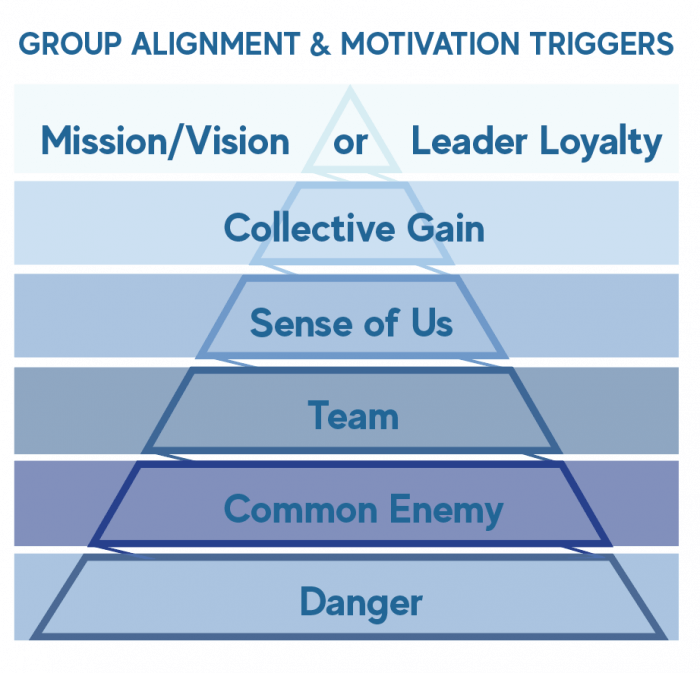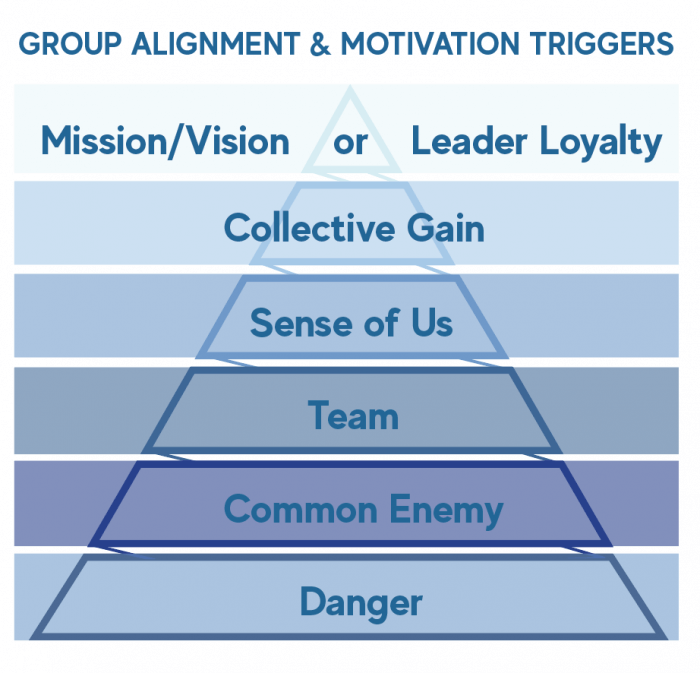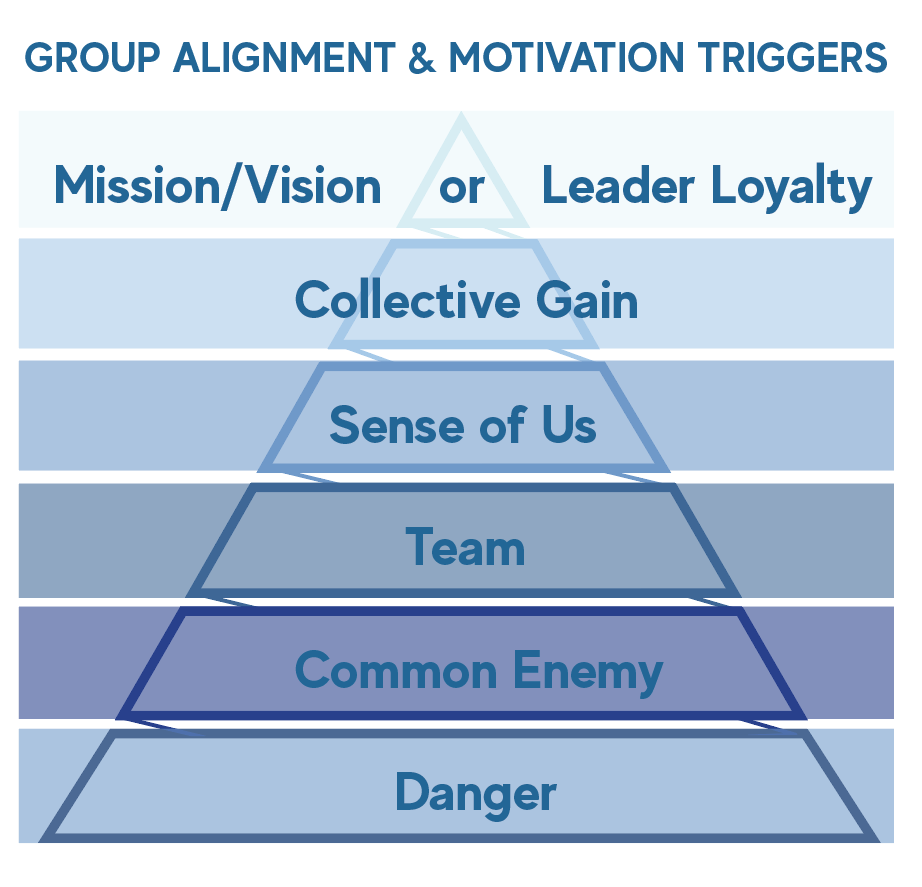Bring People Together
There are times when it is extremely useful to be able to bring people together to create a sense of alignment and shared purpose and to have a sense of being Us rather than Them.
Bringing people together in various settings to create a sense of group identity and shared purpose can sometimes be an extremely useful and important thing to do, and that is true because having people aligned can support Peace — and having people feeling divided in any setting too often facilitates, enables, encourages and reinforces negative interactions and emotions.
We divide the world into Us and Them as a normal way of thinking in almost all settings — and we are often very well served if we can get people in a setting to have a sense of being Us in relevant ways with one another that cause people to be supportive of each other instead of being antagonistic, fearful or even angry with one another.
It is clearly very dangerous in many settings to have people perceive other people in that setting to be Them. With all of the powerful and often very negative instinct shaped thoughts, emotions, and behaviors that perception too often creates.
We are fortunate to know several easy to understand factors that can be invoked and triggered to help people in any setting create at least a temporary and situational sense of Us for that setting.
Sometimes a truce all you need…and these factors can help create a context for truce.
Create Alignment
They can also create longer term alignment.
The six triggers on this pyramid can be used in almost any setting to help create internal alignment in the setting.
Those triggers are based very directly on instinctive ways of thinking, and they each derive part of their power and impact from the fact that we feel instinctively correct and aligned when we act in their paths and behave in their ways.
It is good to know and understand how these instinct supported trigger factors can be used in many group and inter group settings to help make a sense of internal alignment happen for that setting.
People who want either inter group Peace or internal Peace within a group are often well served by knowing what those triggers are and how to use them. Knowledge is power.
When we know the specific kinds of factors that can be used to bring people together in ways that trigger an instinct supported sense of alignment, then we can look at situations and we can figure out whether or not to use those triggers in any given setting to achieve that goal.
The triggers are tools.
We can have more power and we can have both direct and intentional influence over group settings of various kinds when we know the specific approaches and factors that can cause people in that setting to have a sense of alignment and shared purpose in one or more areas of their interactions with one another.
Those tools are very effective. They have been tested and used in multiple settings — and they have the ability to get people in any setting to both have a sense of alignment and even to create a sense that the people in the setting can function as an Us for at least some of the things they are doing.
It can be extremely useful to get people in any setting to be able to achieve a sense of being Us in that setting for at least some of their behaviors and interactions because that sense of being Us instinctively triggers very useful sets of internal support beliefs, behaviors, and even emotions for people in that setting.
We need to accept our Us/Them instincts as a perpetual reality, and we need to intentionally and skillfully use them for Peace and not conflict.
Our core sets of instincts that cause us to divide the world into Us and Them and to act and think very differently about people when we perceive them to be either Us or Them have a very large influence on our lives. The InterGroup books and website explain those instincts in great detail multiple times because our Us-Them shape many of our thoughts, emotions, behaviors, and even beliefs.
We definitely want people to feel like an Us in settings where we want people to be aligned and to be supporting one another.
Settings where people perceive other people to be Them tend to be troubled and difficult settings, and settings where people perceive other people to be Us can be much more positive and supportive situations and settings.
Use Triggers for Positive Change
Each of triggers can be used alone to good effect, and they can have even more impact when they are used together as a package in any setting.
Those factors work because they each have very deep instinctive roots.
Our instincts allow us to use those triggers both for inter group alignment and to reduce inter group conflict and disagreement, and they can also be used within a group to strengthen and define internal alignment inside the group.
Group leaders often invoke these triggers in a variety of ways to increase their own power and influence over their groups and to get support from group members.
This pyramid owes a huge homage to Dr. Maslow and his extremely well known and intellectually powerful Hierarchy of Needs pyramid.
The Institute for InterGroup Understanding pyramid to illustrate those triggers both resembles and echoes Dr. Abraham Maslow’s Hierarchy of Needs pyramid.
The Institute has been using the internal group alignment trigger pyramid since l987 — and it has been useful in a wide range of group and inter group settings as a way of creating both identity purpose for groups of various kinds.
The Institute Pyramid looks like this:

In a parallel to having the base level on Dr. Maslow’s hierarchy being functional physiological needs for each person, the base trigger used on the InterGroup Alignment Pyramid is Danger.
Danger
Danger works.
Danger has great power to bring people together.
People in all settings have a strong emotional and clearly instinctive tendency to ally with one another and to work intentionally with one another if people perceive that a real danger of some kind exists — and that working together and being aligned will help reduce or end the danger.
Danger is an extremely powerful motivator and it can be used to create alignment in any setting where it is relevant.
We all have strong survival instincts — and a sense of danger can cause us to be aligned to survive.
Common Enemy
The next level up on the alignment trigger hierarchy is Common Enemy.
People everywhere tend to find it easier to be aligned if there is a belief that a common enemy exists that will be countered, defended against, or overcome and defeated by alignment.
“The enemy of my enemy is my friend” is a common saying in multiple cultures and people always understand it because it can be so obviously true.
Team Instincts
The level above common enemy on the group Alignment Trigger Pyramid is Team. We love being on teams. We can do very well as teams.
We have very strong instincts that support us on team behaviors, team emotions, and team thought processes. When people believe that they are truly on a team in some setting, and when the identity and purpose of the team seems legitimate — then a very powerful package of team instincts can be activated that can guide behaviors in very useful ways.
Those instincts can include having a sense of team loyalty and internal team- based emotional support.
Sense of Us
The level above team behavior on the Alignment Trigger Pyramid is having a Sense of Us. People feel a deep need to have at least one sense of Us in their lives.
We all have a clear instinctive need to have a group identity of some kind that allows people to perceive that they are part of an Us of some kind. People with no sense of Us can have clear levels of stress and anxiety.
It is very useful for the alignment process to understand that we each have significant flexibility in identifying groups of Us, and multiple categories of being Us can trigger that sense of alignment and inclusion.
Family tends to create and trigger strong Us alignment. Other categories like community identity, professional status, and both race and culture can trigger those levels of alignment.
Corporations sometimes use a combination of brand and culture to create a sense of Corporate Us — that can be useful for steering people in the organization in directions that the corporation wants its people to go. Labor Unions also often create a sense of Us, and that particular sense of Us is sometimes accompanied by a clear sense of Them in some settings.
Those Us instincts create alignment best when they represent a clear group identity at some level, and when we believe that the group is one that includes us in a credible way and that we believe wants Us to do well and be either successful or safe.
Dr. Maslow includes “Belongingness” as one of the middle core motivators on his core pyramid. That motivation factor of individual belongingness is very reinforcing for the Sense of Us trigger on the InterGroup Alignment Pyramid.
Collective Benefit or Gain
The level above group identity in terms of triggering alignment in group settings is a sense of Collective Gain. When we believe that an alignment will make us wealthy or financially enhanced — that belief can be very motivating.
Gain comes in many forms. Being aligned to have pension plans or to achieve better education for our children can also trigger a sense of group support and positive interaction. Any sense that we will prosper or that we will personally acquire things by being aligned tends to support the behaviors of alignment and keep people in the group for those purposes.
Mission, Vision, or Leader Loyalty
The highest level on the group Alignment Pyramid has two alternative manifestations.
The highest level of the Maslow Hierarchy of Needs pyramid is “Self-actualization.”
Similarly, the highest level on the InterGroup alignment trigger Pyramid is either Mission and Vision or Leader Loyalty.
Both sets of triggers work at that aspirational level to get people aligned. People will come together in a belief system, religion, ideology, or shared aspiration and people will support and accept each other in the context of that shared belief.
Mission/Vision can have great power to both influence lives and to bring people together in positive and mutually reinforcing ways.
The other trigger for aligned behavior and shared identity at the very top level of alignment is Leader Loyalty.
Leaders have their own sets of alpha instincts that we all should understand because of how they affect our directions and thinking in various settings.
We have very strong instincts to be loyal to our leader. We have strong alpha instincts that create alpha status for our leaders in our hierarchies everywhere, and we tend to have strong loyalty to our leaders in ways that create both internal alignment within a group and clear sets of behaviors in support of those leaders.
That can apply to multiple kinds of groups.
Families can feel deep loyalty for heads of families that cause people to have aligned behaviors in that direction and to feel strong instinctive levels of support for family heads.
Gangs also can trigger a very similar set of instincts — and many gangs have their highest direct loyalty levels to the leaders of their gang in very clear ways that clearly define the behavior priorities for many gang members in many settings.
We tend to feel right at some deeply instinctive levels doing what our gang leaders and our group leaders and even our family leaders direct us to do.
For any given group, we have the option of having our loyalty being to a mission, vision, or ideal, or to a leader of some kind who triggers direct loyalty in that role.
It is very good for each of us to understand which of those approaches is being used in the groups we are in.
It is also good for each of us to understand that the group alignment pyramid might be good to use as a tool kit in the settings we are in.
The InterGroup Books Explain How to Use Instincts and the Pyramid
Each of the InterGroup books has chapters on how to use that pyramid and those triggers for both support and inter group Peace.
Chapter Eleven in Primal Pathways is titled The Six Instinct-Linked Pathways and Key Triggers for Alignment. Twenty-seven pages in that book are dedicated to that topic and that description tees up the triggers as being instinctive at their core.
Chapter Eight in The Art of InterGroup Peace is titled Six Steps and Six Triggers to Use to Create Instinct Supported Alignment.
That chapter takes 74 pages to explain that group alignment trigger tool kit because that book is about ways we can create Peace between groups and it explains practical use of the tool.
Peace In Our Time has two case study related chapters on the topic: Chapter Seven and Chapter Eight.
Chapter Seven is titled Six Basic Alignment Triggers That Can Get People to Form Groups In Almost Any Setting.
That chapter is over forty pages and includes a number of case studies from work settings about use of those triggers.
Chapter Eight is called We Used the Six Step Alignment Pyramid to Organize Groups In Uganda and Jamaica.
That chapter takes fifteen pages that describe case studies and field activity that occurred in both Jamaica and Uganda in getting local people to create health care delivery organizations that used the alignment pyramid in their formation and development.
Each of those InterGroup books explains why each of the Six Triggers work.
And each of the books explain and describe how to use the Six Triggers in almost any inter group setting to reduce conflict and increase alignment.
The InterGroup Alignment Trigger Pyramid is worth knowing for both groups and their leaders, because it can be used in a wide range of settings to get people to work together and to believe in a common purpose and identity and direction for the people in the group.
We Can Use the Triggers in Any Group or Inter Group Setting
In any group or multi group setting, you can look at the situation that exists now for the groups in the setting and you can very intentionally use any or all of these six triggers to bring people together or to keep people together in a group status of some kind.
People who want to damage a group can also use any or all of The Pyramid points inside a group in negative and divisive ways either to split groups or to drive aligned groups apart.
Creating divided subgroups is often done by people in a setting who either want group alignment to fail, or who have their own power aspirations and who want to spin off a section of the larger group to be under their control.
Like most instincts, these alignment tools can be used for good or evil.
They can bring people together or they can split them apart.
The book chapters explain how to use those triggers to achieve either set of goals.
We need to come together as a country to avoid serious inter group conflict at this point in our history — so the hope is that they are used for alignment rather than division.
Take a look at these triggers and figure out how they are either relevant to where you want your group to go, or how they are being now by your own leaders to either bring people together or force them apart.
It isn’t hard to see either strategy in your own group or in other groups in your community when you know what these triggers are and when you know and see how they work.


